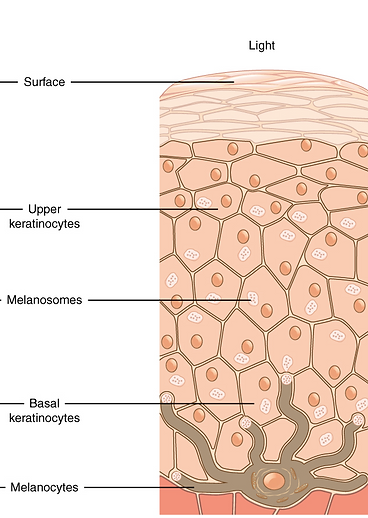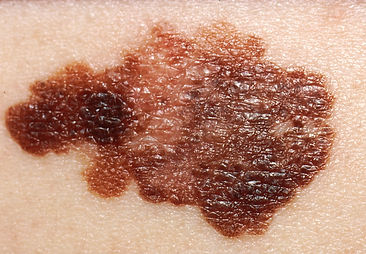
Melanoma
Progression:
A Melanoma tumor is created when the DNA of a melanocyte is damaged...usually by UVB radiation. (See Risk Factors page above) After the initial mutation occurs, the damaged melanocyte is considered melanoma. Mutations that cause melanoma halt apoptosis, or cell death, and eliminate regulation of cell reproduction. This means that melanoma cells live longer and reproduce more frequently than normal melanocytes. Once these changes occur, the melanoma will begin to spread. The melanoma does not perform the function of normal melanocytes, and is completely unhelpful to the body. It uses nutrients intended for functioning tissues to increase its size.
At some point the melanoma enters the lymphatic system and has the ability to spread to remote parts of the body. The melanoma will grow larger and appear in many parts of the body, stopping more and more tissues from functioning until it attacks something critical like the brain or lungs. When the patients vital organs are compromised he or she will die.
Melanoma progression is divided into five stages. In Stage 1 a carcinoma, or tumor, is visible but not larger than 2 centimeters long or deep. The carcinoma will look like a mole, or may form in the place of a pre-existing mole. Compared to normal moles, melanoma tends to have a more uneven shape and patched coloring. Additional symptoms may include itching and bleeding. Stage 1 melanoma is not harmful and can be easily treated if identified.
Stage 2 means that the melanoma has grown and its greatest dimension, width or depth, measures between 2 and 5 centimeters. If the tumor exceeds 5 centimeters it is then classified as stage 3 melanoma. However, Stage 3 can mark more than additional growth in the width and depth of the tumor. Towards the end of Stage 3 cancerous cells may spread into the local lymphatic system. At this point there is a possibility that the melanoma could spread around the body, but there is no evidence to suggest it has done so. Surgery at this stage is still possible but not as successful as in earlier stages.
Stage 4 is the most advanced form of melanoma. At this stage the melanoma has spread through the lymphatic system to distant parts of the body, and is considered “malignant” melanoma. Very few people successfully recover from Stage 4 melanoma, and most die within the first year. Because the melanoma has dispersed through the lymphatic system, surgery is no longer a solution. Researchers are still trying to develop a cure for Stage 4 melanoma. A patient may use drugs already on the market, which have been shown to delay but not prevent the progress of malignant melanoma, or participate in a clinical trial of a new drug that may be more successful. Either way their situation is a desperate one, which is why early identification of melanoma tumors is so crucial.

Melanocyte location within our skin. Diagram shows epidermal layer only.

Early melanoma tumor
